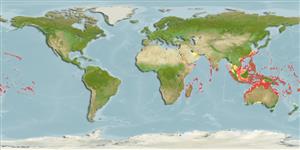Actinopterygii (ray-finned fishes) >
Perciformes (Perch-likes) >
Acanthuridae (Surgeonfishes, tangs, unicornfishes) > Nasinae
Etymology: Naso: Latin, nasus = nose (Ref. 45335).
Environment / Climate / Range
Ecology
Marine; reef-associated; depth range 2 - 122 m (Ref. 58302), usually 4 - 46 m (Ref. 27115). Tropical; 24°C - 28°C (Ref. 27115), preferred ?; 29°N - 36°S, 26°E - 137°W (Ref. 57250)
Indo-Pacific: Red Sea and East Africa to the Hawaiian, Marquesas and Ducie islands, north to southern Japan, south to Lord Howe Island. Excluding Oman and Persian Gulf (Ref. 86689). Eastern Central Pacific: Galápagos Islands.
Size / Weight / Age
Maturity: Lm ? range ? - ? cm
Max length : 60.0 cm FL male/unsexed; (Ref. 1602)
Dorsal
spines
(total): 6;
Dorsal
soft rays
(total): 27-29;
Anal
spines: 2;
Anal
soft rays: 27 - 30. Adults bluish grey to olivaceous brown in color, commonly pale anteriorly and on cheek and throat; short irregular lines on sides of body; diagonal lines on horn; lip edges blue (Ref. 3145). Subadults with dark spots on head and body (Ref. 3145). Juveniles lack the prominent horn of adults (Ref. 1602).
Inhabit mid-waters along steep outer lagoon and seaward reef drop-offs. Also found along rocky shores (Ref. 30573, 48637). Benthopelagic (Ref. 58302). Usually in small groups but form large schools in oceanic locations or on reefs subject to strong currents (Ref. 48637). Juveniles and subadults feed on benthic algae; adults feed on zooplankton. Pair spawning has been observed. Caught with nets (Ref. 30573).
Life cycle and mating behavior
Maturity | Reproduction | Spawning | Eggs | Fecundity | Larvae
Probably spawn in pairs (Ref. 240).
Myers, R.F., 1991. Micronesian reef fishes. Second Ed. Coral Graphics, Barrigada, Guam. 298 p. (Ref. 1602)
IUCN Red List Status (Ref. 115185)
CITES (Ref. 94142)
Not Evaluated
Threat to humans
Reports of ciguatera poisoning (Ref. 30298)
Human uses
Fisheries: commercial; aquarium: commercial
More information
ReferencesAquacultureAquaculture profileStrainsGeneticsAllele frequenciesHeritabilityDiseasesProcessingMass conversion
Tools
Special reports
Download XML
Internet sources
